Looking back on “Gender-Sensitive Economic Recovery and Resilience in Asia”
A March 2023 conference in Tokyo explored factors that enable and constrain women’s economic activity in Asia, and how research can inform pandemic recovery policies and gender-sensitive responses to future shocks. Erik Jorgensen of Inclusion Economics at Yale University, a joint initiative of EGC and the MacMillan Center for International and Area Studies, summarizes the program.

Charting a gender-inclusive path for post-pandemic recovery and resilience in Asia
At the outset of the Covid-19 pandemic, many public figures wondered if the shared experience of economic disruption would serve as a great equalizer. It soon proved to be the opposite. Lockdowns, job losses, and intra-household dynamics, exacerbated by a new way of life, widened existing inequalities within society – including those between men and women. How can we ensure that women and girls are included in recovery programs and that the next crisis does not put them at further economic and social disadvantage?
To help answer these questions, the Asian Development Bank Institute and Inclusion Economics at Yale University cohosted the Gender-Sensitive Economic Recovery and Resilience in Asia Conference in Tokyo March 9-10, 2023. The event convened researchers and policymakers in the region to discuss a recovery period in a complex landscape of shocks – not only in public health, but also climate and conflict. Presentations examined what we know about how the economic and political status of women has changed during the Covid-19 era, and what policies can help ensure that post-pandemic recoveries and preparation for future shocks are gender-inclusive.
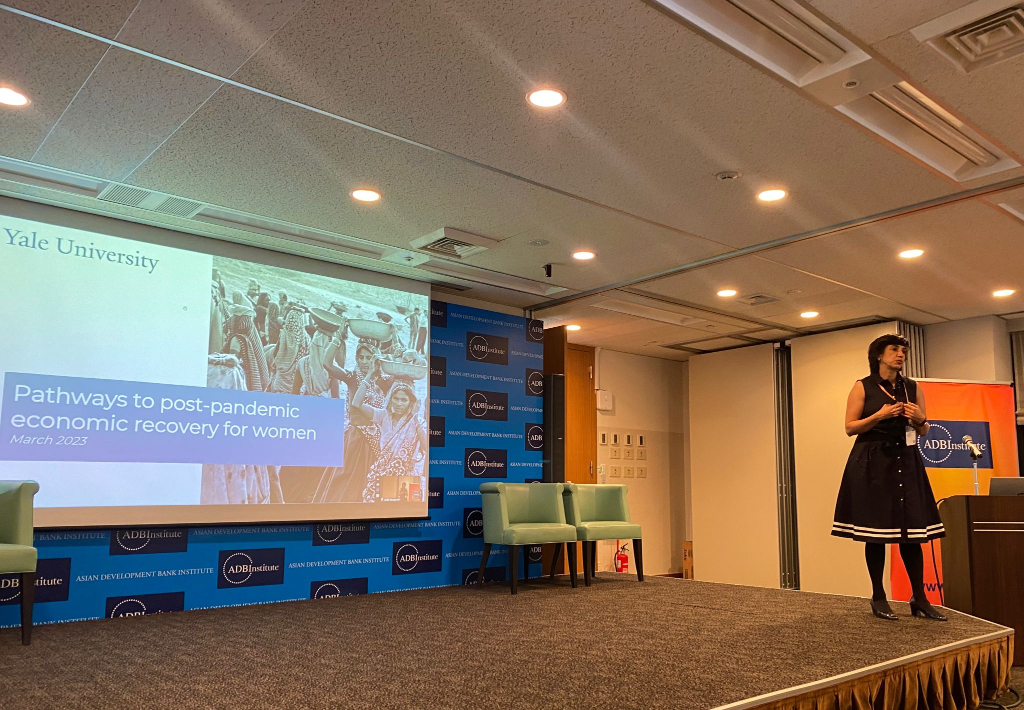
Rohini Pande delivering the first keynote.
Pathways to post-pandemic economic recovery for women
The first keynote of the conference was delivered by Rohini Pande, Henry J. Heinz II Professor of Economics and Director of Inclusion Economics at Yale University. She outlined the dual forces keeping women from fully recovering from the pandemic. First, women were pushed out of the labor market at higher rates, working in less stable jobs and in sectors hit the hardest by lockdowns, like the service industry. Second, they were pulled into relatively more household duties, and were more likely to exit the labor force due to marriage, pregnancy, and difficulties remigrating to areas of economic opportunity. Underlying and driving both of these forces were restrictive gender norms. The degree to which women were affected by these forces was further influenced by characteristics like geographic location, economic status, and household dynamics. Pande used novel analysis of national datasets and household data from a recent impact evaluation in the Indian state of Madhya Pradesh to illustrate women’s different experiences of the pandemic in India, drawing particular attention to the successes of government social protection programs for rural women, and the need for more targeted support for young urban women.
WATCH THE KEYNOTE
Policy Panel
- Roli Asthana, United Nations
- Erik Berglof, Chief Economist, Asian Infrastructure Investment Bank
- Takahiro Sawayanagi, Advocacy Officer, Plan International Japan
- Hans Timmer, Chief Economist, South Asia, World Bank
- Moderator: Charity Troyer Moore, Scientific Director, Inclusion Economics at Yale University
How do we translate economic research into systemic change that transforms women’s economic and political status in the region? The policy panel on day 1 of the conference discussed how our actions can drive forward positive change for women.
One important theme that came out of the discussion was that of starting at home: organizations seeking to promote gender inclusivity and female empowerment must first look at their policies, equity, and the very composition of their advisory boards. They cannot advise institutions on creating gender-sensitive policy without women sitting at the decision-making table. Beyond this, the panel discussion brought to the forefront the tension between supply- and demand-side constraints to female employment: highlighting how, among others, job scarcity and restrictive gender norms are factors keeping many women in the region out of the labor force – with experts expressing differing views on the relative importance of both.
WATCH THE POLICY PANEL
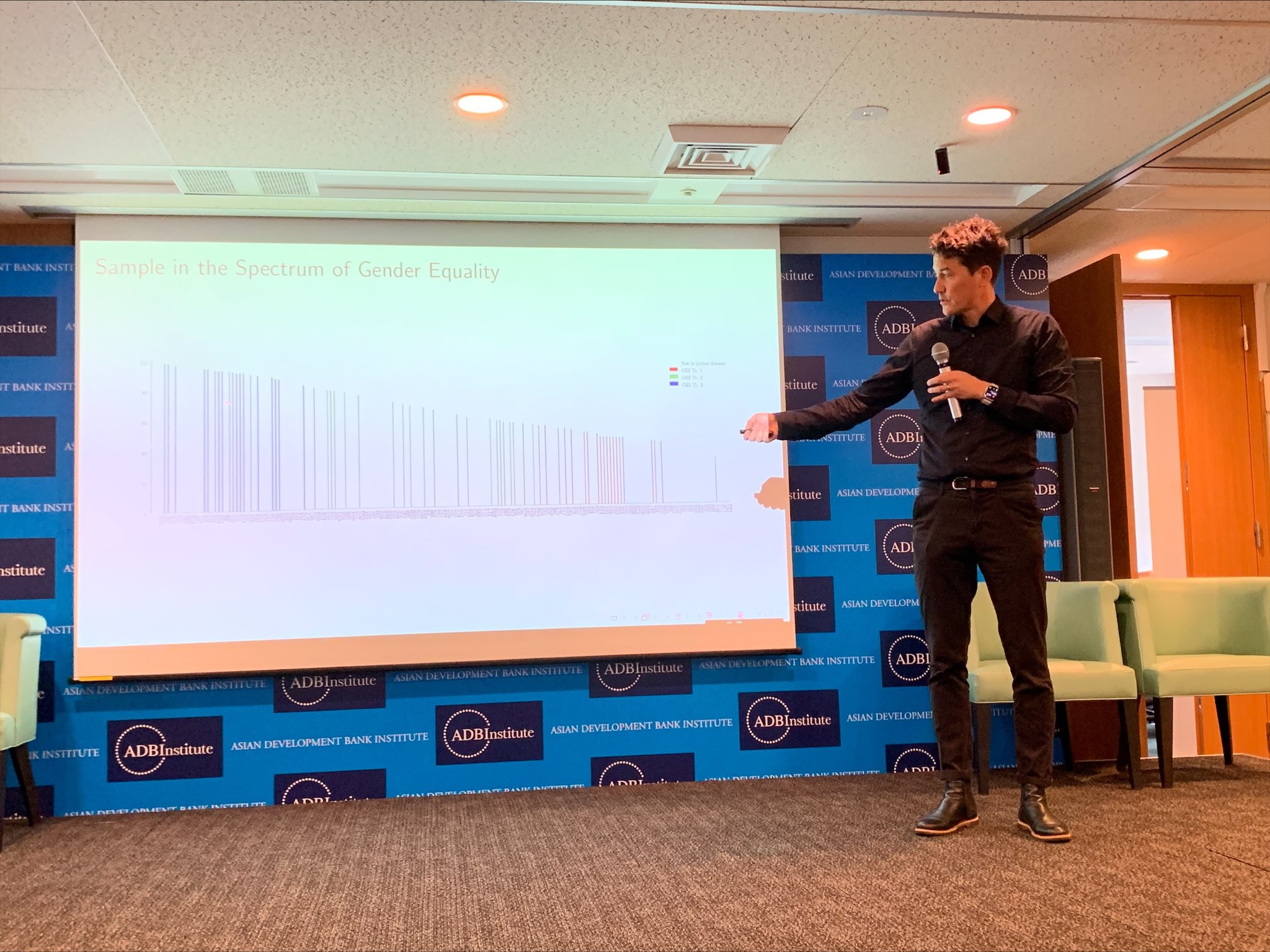
David Yanagizawa-Drott delivering the second keynote.
How are gender norms perceived?
The second keynote was delivered by David Yanagizawa-Drott, Professor of Economics at the University of Zurich. He posed the question: “if restrictive gender norms are so central to the limitation of economic opportunity for women, what do we know about how widely these views are held, and do societal norms reflect the typical individual beliefs of men in society?” Using survey data collected in 60 countries worldwide, he established that societal norms are not direct reflections of individual beliefs – presenting four stylized facts:
- Support for basic rights for women is universally underestimated.
- Men’s support for basic rights for women is more underestimated than women’s support.
- Support for affirmative action for women is underestimated in low-gender-equality countries and overestimated in high-gender-equality countries.
- Men’s support for affirmative action for women is more underestimated than women’s support in almost all countries. In low-gender-equality countries, both men’s and women’s support are underestimated, while women’s support is overestimated and men’s support is not misperceived in high-gender-equality countries.
WATCH THE KEYNOTE
Conference Agenda
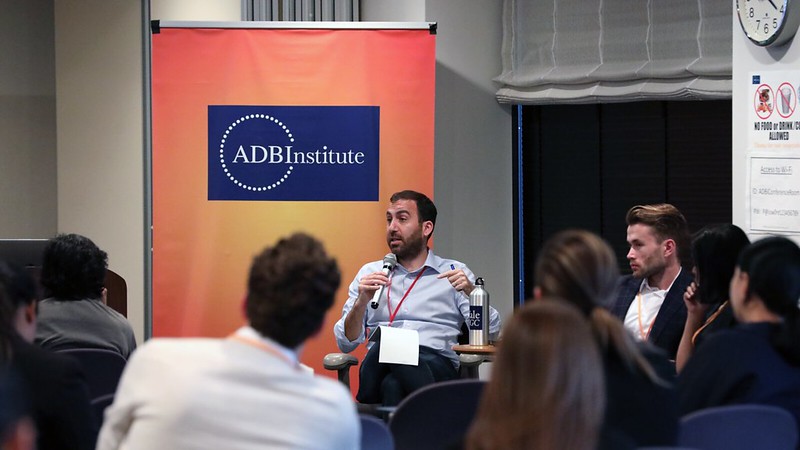
The conference's keynote speakers were Rohini Pande of EGC and David Yanagizawa-Drott of the University of Zurich. A full list of conference sessions and links to papers are available on the agenda page.
Paper summaries
Structural transformation and women’s economic participation
- Michael Peters presented a paper showing that productivity growth in non-tradable services such as retail, restaurants or residential real estate was an important driver of Indian growth between 1987 and 2011. The main beneficiaries of this, however, were rich city-dwellers.
- In China, women’s labor force participation rates and wages have been declining relative to men. Mariya Brussevich presented research on how China’s rebalancing and marketization of services can reduce gender inequality.

Maryia Brussevich presenting "China’s Rebalancing and Gender Inequality".
Cross-country evidence on women’s economic participation
- Charles Gottlieb and coauthors harmonized time use surveys across countries to document patterns of market work, household production and sector of work across the development spectrum for different demographic groups. They found that the decline in women's market hours was driven by a large income effect of spousal wage.
Shocks and women in Asia and the Pacific
- Xiaobo Zhang showed that the expansion of e-commerce has promoted female entrepreneurship in China, using enterprise surveys as well as administrative data.
- Using household survey data from 17 Asian countries, Dina Azhgaliyeva showed how households have mitigated the adverse impacts of the Covid-19 pandemic on their family business.
- Women’s self help groups (SHGs) in India likely contributed to mitigating food insecurity during the pandemic, but they also faced disruption in savings, according to a study by Garima Siwach and coauthors.
Gender and matching frictions
- Nivedhitha Subramanian investigated how much of the gender work gap in South Asia comes from supply versus demand factors using detailed job platform data, plus a resume experiment with employers.
- Information on the quality of overseas job placement agencies makes migrants choosier and helps them secure better jobs, according to a study presented by Simone Schaner.
- Tracing the recruitment process for highly competitive civil service exams, Niha Singh and coauthors found that high-scoring women are less likely to re-apply over time than high-scoring men, affecting their chances of selection in the bureaucracy.
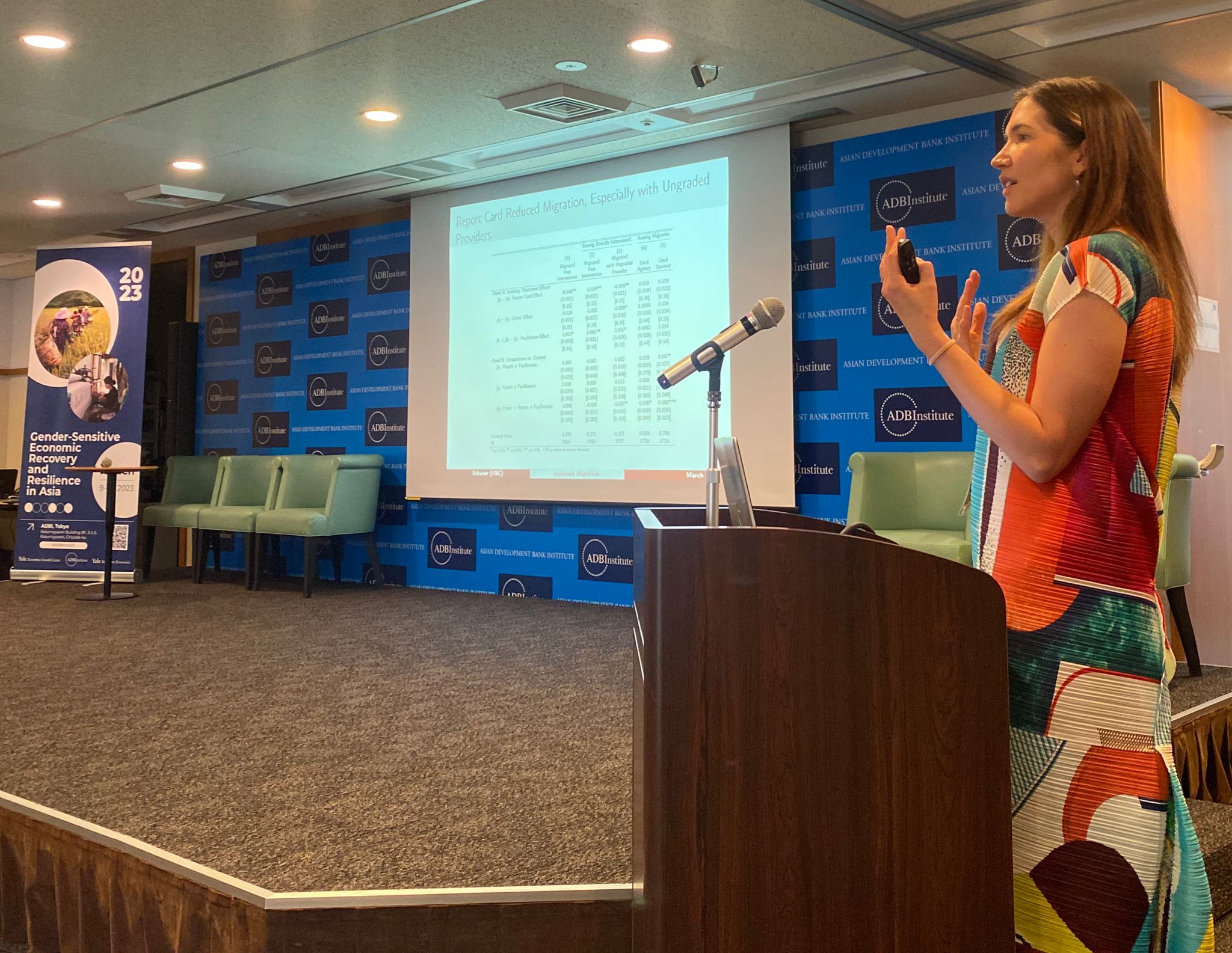
Simone Schaner presenting "Information, Intermediaries, and International Migration"
Children and labor supply
- Elizaveta Perova and co-authors found that the rapid expansion of preschools in Indonesia resulted in novel short-term economic impacts of childcare services for manufacturing firms.
- Rosa Abraham and coauthors use a Life History Calendar approach to reveal that women in India have a sharp and sustained increase in labor force participation after marriage, and no labor market penalty after childbirth.
Gender and networks
- Juni Singh presented a paper that showed how network ties can help facilitate entrepreneurship for women. With randomized controlled trial and network data collection in 30 Nepali villages, she finds that depending on network positions, a link might help motivate women towards opening a business.
- Youjin Hahn and coauthors compare the social norm effect and social multiplier effect in India, and find that when a woman has one additional peer who works, her probability of working increases by approximately 10%.
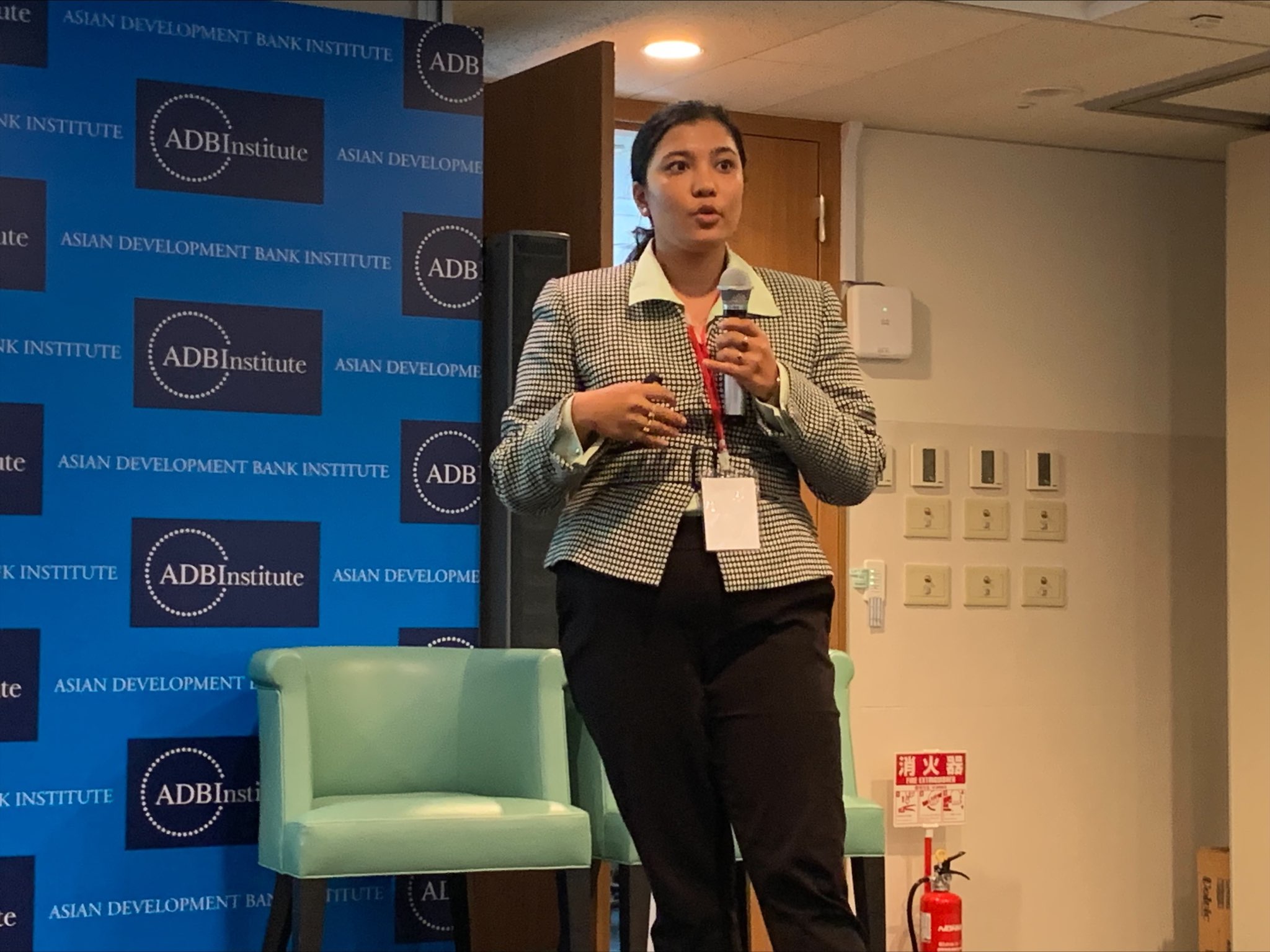
Juni Singh presenting "Can network ties help women with entrepreneurship?"
Gender and norms
- Targeting edutainment at men, or men and women jointly, reduces girl child marriage in target households. A study by Rachel Cassidy and coauthors in Pakistan found that targeting women with the edutainment does not reduce child marriage in the households, as it is women who update their beliefs but are constrained by low household bargaining power.
- Political parties in Korea counteract gender quotas by putting forward fewer women where they can. However, the study found that parties gradually reversed their reaction, and the ones that faced stricter quotas put forward more women 16 years later. Jay Euijung Lee presented work with Martina Zanella showing that the shift is due to parties learning about the competence of women, as opposed to a growing taste for women or an improving pool of women.

Jay Euijung Lee presenting "Learning about Women's Competence: the Dynamic Response of Political Parties to Gender Quotas in South Korea"
Historical male-biased sex ratios in Australia drove expression of masculinity norms through greater male-male competition, the effects of which persist to this day and have health and economic implications. Victoria Baranov and coauthors found that men in these skewed sex ratio areas were more likely to be Covid-19 vaccine hesitant.
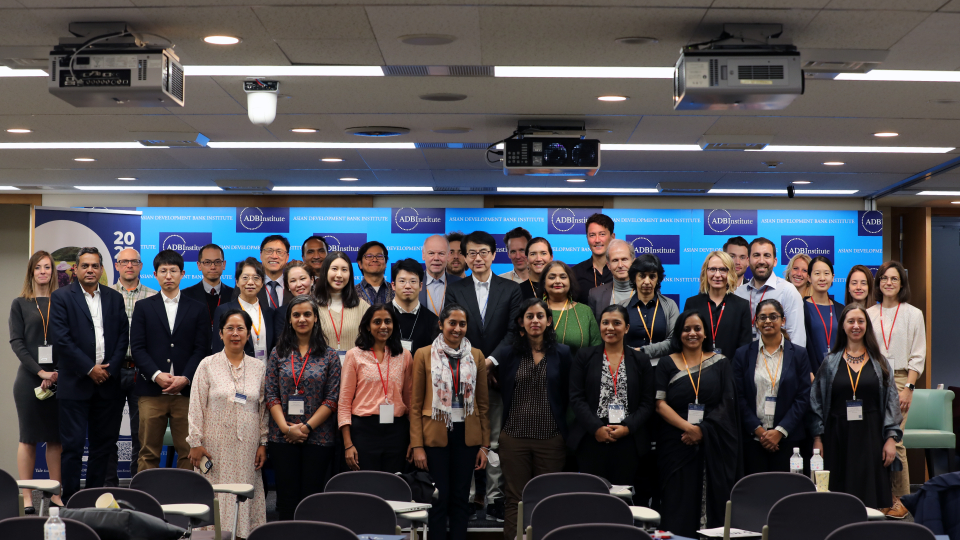
Group photo of conference participants.
Embedding a gender lens in the pathway to recovery and resilience
As the structures of economies change and the cadence of shocks accelerate, underlying gender norms will continue to shape disparities in women’s agency and empowerment, both at home and in the labor force. This complex web of barriers requires an equally complex set of policy solutions. Looking forward, Inclusion Economics and its collaborating institutions will work to embed a gender-sensitive lens into the policy discourse as countries seek to build resilience to future shocks for all citizens.